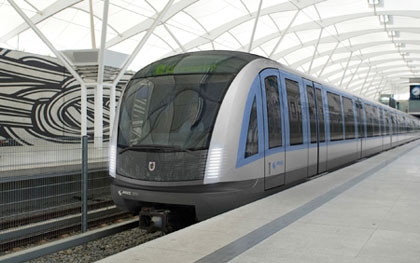Siemens to supply underground trains to Munich
The 21 new trains are to be delivered between 2013 and 2015. They will be deployed in Munich Public Transportation Company’s (MVG)underground network, which covers a total of about 100 track kilometers.
 |
| New C2.11 type underground train (simulation) Source: SWM/MVG |
At the same time, SWM have taken out two options on a further 46 underground trains, totaling 276 cars, which can be exercised until 2016 and 2020, respectively. The total volume of the order, including these options, is around 550 million euros.
Hans-Joerg Grundmann, CEO of the Siemens Mobility Division, said, “We’re proud to be able to continue our longstanding customer relationship with SWM and its subsidiary, MVG. This order represents a milestone project for us in our home market. During the development of the Munich vehicle we placed particular importance on environmentally clean, low CO2 technology.”
The further development of today’s C car enables Siemens to build on the success of the previous car generation, for which Siemens had already borne full responsibility as general contractor. This service-proven system is combined with innovative technologies reflecting the latest developments in metro vehicles marketed by Siemens under the name Inspiro. The technologies ensure a high degree of reliability and comfort.
For Munich, Siemens will supply metro trains that are especially eco-friendly and energy-efficient. The reduced energy consumption is attributable to a combination of different innovative designs. When choosing the materials for this order, the Siemens engineers were guided by environmental concerns: for example, avoiding harmful substances, replacing the halogen lamps in the predecessor vehicle with LED lights, and using materials that ensure up to 97 per cent recyclability.In this way, the new underground train will enhance the CO2 balance in Munich, and assist both SWM/MVG and the city in their efforts to further reduce the amount of energy consumed in the public transportation sector.
The car bodies are made entirely of a lightweight aluminum alloy that lowers the overall body weight and, consequently, power demand of the train. As an option, these trains can be fitted with energy storage units. They are part of the Siemens environmental portfolio that enabled the company to achieve sales of approximately 28 billion euros in fiscal 2010. This makes Siemens the world's largest supplier of environmentally clean technology.
Carrying around one million passengers per day, the underground system is the most widely used means of public transportation in Munich.
The current order for Siemens comprises 21 trains totaling 126 cars. These cars are a further development of the reliable C car design for the previous generation of vehicles, which were designed by the international known car designer Alexander Neumeister. The trains are 115 metres long and 2.90 metres wide. They resemble the latest generation of underground cars which have been in service since 2002.
External changes include the front section, which features new LED lighting technology, and colored LED light strips in the edges of the doors for easier recognition of door opening and closing operations. Video cameras, passenger TV and redesigned interior lighting using LED lamps provide a higher level of comfort for passengers.
Compared to the maximum speed of 80 kilometres per hour of the previous generation, the C2 car not only has a top speed of 90 kilometres per hour but can also accelerate more quickly. Other advantages of the train are its high capacity and availability. The new cars have a redesigned passenger area, a new seating concept and wider doors, so they can carry more passengers than the old vehicles they are replacing. A C2 train can accommodate 940 passengers. As separate cars have been eliminated, the train now offers passengers end-to-end accessibility.
Highly reliable technology has been used throughout the new vehicles. The systems used require very little maintenance, which lengthens maintenance intervals and increases the availability of the underground fleet for the operator.
What the stars mean:
★ Poor ★ ★ Promising ★★★ Good ★★★★ Very good ★★★★★ Exceptional
 Tag:
Tag:
Related Contents
Latest News
More News
- Global partnerships key to Vietnam’s IFC development (December 26, 2025 | 16:18)
- Vingroup pulls out of bid to invest in North-South high-speed railway (December 26, 2025 | 11:42)
- Strengthening supply chains through trade promotions and customs reform (December 24, 2025 | 14:00)
- PM orders investment model for North–South high-speed rail (December 22, 2025 | 17:43)
- LS Eco Energy to invest in Vietnam rare earth sector (December 22, 2025 | 17:31)
- Government moves to establish International Financial Centre (December 21, 2025 | 21:00)
- Vietnam's IFC to target global investment flows (December 21, 2025 | 18:00)
- Two national hospitals expand capacity with new facilities (December 20, 2025 | 09:00)
- Ha Tinh breaks ground on major Vingroup industrial and energy projects (December 19, 2025 | 18:24)
- EVN launches major power infrastructure projects nationwide (December 19, 2025 | 18:17)























 Mobile Version
Mobile Version